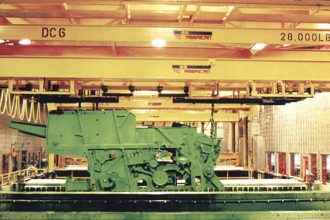
Designed and installed to assist with handling a load, workstation cranes improve ergonomics by making it easier and less strenuous for an operator to lift, lower, position, turn, or move a workpiece. They can be engineered to handle a wide range of load weights and reduce the risk of injuries associated with repetitive stress and overexertion associated with pushing, lifting, or pulling heavy objects. Additionally, workstation cranes assist with precise load positioning and reduce fatigue, improving overall efficiency and productivity.
Using a workstation crane for moving and manipulating heavy loads addresses the number one cause of disabling workplace injuries (back and shoulder sprains and strains) — handling objects — according to Liberty Mutual Insurance’s “2020 Workplace Safety Index: The Top 10 causes of Disabling Injuries.” These types of overexertion injuries can cause employees to miss work for more than five days cost employers $13.98 billion annually, based on both medical and lost-wage expenses. According to IRIS FMP, the average claim against an employer for back pain costs between $40,000 and $80,000. Reducing the risk of such an injury occurring is often a key contributor to the cost justification for an investment in one or more workstation crane systems.
Often used in manufacturing and assembly work cells, a single workstation crane is typically dedicated to a specific location or area to facilitate a task or process. Depending on the operation and the facility, the cranes may be either ceiling- or floor-supported and are equipped with an end truck or trolley to move the load laterally, a hoist or pneumatic balancer to raise or lower it, and a load handling device that connects the load to the crane.
Once the load has been lifted, the operator guides and positions it, either manually or with the assistance of a powered end truck or trolley. This significantly reduces the amount of physical force and effort required to push and pull heavy loads, improving ergonomics. To ensure operator safety and further reduce the risk of injury, it is important that they complete training on how to properly operate the workstation crane and its components, as well as how to interact with and manipulate the load in the most ergonomic way.
Want to learn more about workstation cranes and how they can help your operators be both safer and more productive? The members of the Monorail Manufacturers Association (MMA) are the industry’s leading suppliers of workstation crane systems. The group offers a variety of resources—including a product certification program, recommended practices for workstation cranes and patented track systems, and more—via its website at www.MHI.org/MMA.



